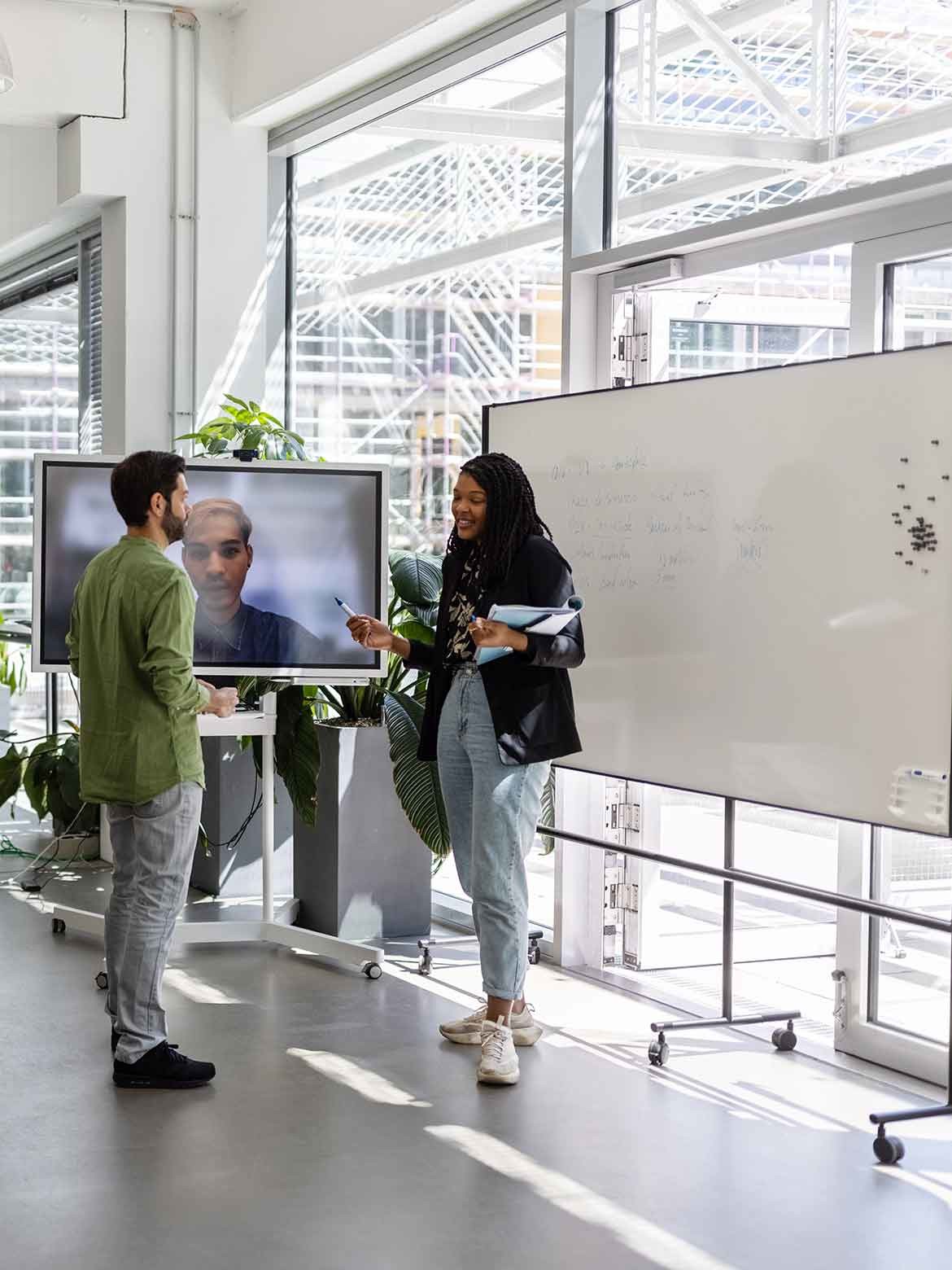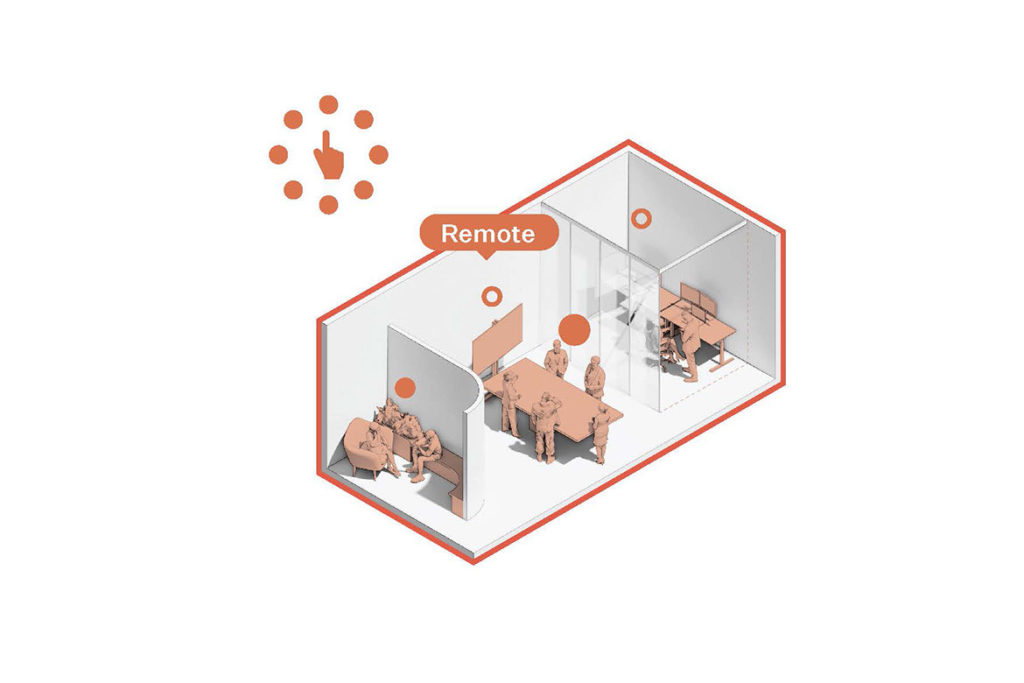Six Ideas by Dexus and Warren and Mahoney shows us how to establish an optimal hybrid collaboration framework. Read this insight-rich article from the presenters themselves.

Left to right, Dexus principal, Dr Kirsten Brown, and Warren and Mahoney principal, Tamara White.
October 6th, 2022
With hybrid working here to stay, Six Ideas by Dexus and Warren and Mahoney (W+M) recently completed a research project that resulted in the creation of a tangible framework for successful collaboration. The study saw etiquette, environment and culture emerge as the three crucial areas organisations must get right in order to thrive in this new reality.
Over a four-month period, respondents from 11 organisations participated in a series of workshops and surveys. Of the 140 participants across legal, local and state government, consulting, design and scientific organisations, 56 per cent of respondents said they were ‘in the office’ five days a week prior to the pandemic.
In contrast, 6 per cent of participants anticipated a five-day in-office working lifestyle in the future, highlighting the imperative to improve the experience and effectiveness of hybrid collaboration.
Six Ideas by Dexus principal, Dr Kirsten Brown, says while a new physical set up is inevitable, organisations should be reminded that effective collaboration, not physical place, has always been the true driver of success:
“The positive outcomes of collaboration are things we have achieved before we had offices.
“Prior to the pandemic, the best work and ideas often involved remote collaboration between organisations who really wanted to work together, regardless of physical constraints. In today’s workplaces, best practice in collaboration takes on a renewed focus as organisations adjust to a workforce with more flexible ways of working.”

Within the study, ‘hybrid collaboration’ is defined as two or more people ‘in the room’ and at least one person is ‘not in the room’. Dr Brown explains that the rationale for this definition stems from nature of the interaction:
“When it’s a one-on-one interaction both parties are on the same platform even though they are separated and on individual devices – its reasonably ‘equal’ and not hybrid. As many of us may have already experienced, the challenges of hybrid collaboration tend to arise when there is more than one person in a physical meeting space interacting with someone else who is remote.
“Before attempting to create a positive framework to maximise hybrid collaboration we asked our participants what they saw as the key benefits of collaboration in itself.
“Of all the respondents we spoke to a range of themes rose to the top, with the four greatest benefits of collaboration being cited as: generating and exchanging ideas (25.2 per cent of respondents); feeling part of a community (16.1 per cent); building organisational culture (15.3 per cent); and, impromptu learning (14.6 per cent).
“However, when we asked participants to plot the ability to effectively achieve these benefits of collaboration in a hybrid working model, a couple of key themes – specifically ‘feeling part of a community’ and ‘impromptu learning’ fell below the 50 per cent line of effectiveness.
“And it was this insight that encouraged us to dig deeper into the collaboration issues and identify holistic solutions through culture, space, technology and behaviour that can support organisations to maximise the benefits and mitigate the risks of a distributed workforce.”

The research – an effort of collaboration in itself – identified the key challenges for businesses seeking to achieve optimal hybrid collaboration before applying their respective experience and broader academic thinking to formulate the recommended framework.
Warren and Mahoney principal, Tamara White, says through the findings of the research the team was able to land on a three-tiered framework to achieve holistic collaboration that could thrive in a hybrid model.
“First is establishing a polished ‘hybrid etiquette’. As the saying goes ‘good manners are just a way of showing other people that we have respect for them’ and they are critical to successful hybrid collaboration.
“Nine guidelines for an ideal hybrid collaboration etiquette have been established. Simple things such as: nominating a facilitator; clarifying if a meeting is formal or informal; checking in to see if everyone can see/hear you adequately; and, nominating a way to capture ‘side conversations’ (for example, in Chat on Microsoft Teams) to ensure they’re not lost when the meeting disbands, can make a big difference to the hybrid experience.”

White says “that whilst this may seem like common sense, very few organisations we spoke with had formalised guidelines to drive better hybrid experiences, despite the widespread dissatisfaction. Simple fixes are often the most effective, so considering how an organisation can set parameters around etiquette is a step in the right direction.”
The second principle focuses on optimising the ‘hybrid environment’, which centres around creating a considered space and purposeful technology to be successful:
“It is important to recognise that technology solutions haven’t kept pace with the demands of hybrid working. While we wait for the technology to become more readily available, we can still create successful solutions with a holistic approach.”
Four lenses of quality, equity, variety and flexibility are provided to help organisations create an ideal workplace space for optimal holistic collaboration.

“Finally, businesses successful in a hybrid collaboration model would give ample consideration to creating the right ‘hybrid culture’,” says White.
“An ‘early-adopter’ attitude and a supportive and open culture that accepts and embraces the future working model – rather than low digital literacy and a fixed mindset – will attract and nurture the best talent and foster a positive culture.
“Our research showed that organisations that embraced hybrid working as part of their culture are now more resilient to change, nimble to adopt new technology, and fundamentally better at hybrid collaboration in a hybrid working world.”

Conclusively, this study has revealed that many collaborators are having a second-rate experience when it comes to hybrid activities, from impromptu learning to formal meetings. Impacting factors range from not yet knowing ‘the rules of engagement’ through to technology that hasn’t quite caught up with how we work.
However, with investment in optimising etiquette, environment and culture, the experience can be improved so organisations can fully leverage the power of effective hybrid collaboration and succeed in the hybrid workplace of the future.
Warren and Mahoney
warrenandmahoney.com
Dexus
dexus.com


Here are 10 of our top workplace stories, plus news on Orgatec, the international workplace fair.
A searchable and comprehensive guide for specifying leading products and their suppliers
Keep up to date with the latest and greatest from our industry BFF's!

BLANCOCULINA-S II Sensor promotes water efficiency and reduces waste, representing a leap forward in faucet technology.

In this candid interview, the culinary mastermind behind Singapore’s Nouri and Appetite talks about food as an act of human connection that transcends borders and accolades, the crucial role of technology in preserving its unifying power, and finding a kindred spirit in Gaggenau’s reverence for tradition and relentless pursuit of innovation.

Within the intimate confines of compact living, where space is at a premium, efficiency is critical and dining out often trumps home cooking, Gaggenau’s 400 Series Culinary Drawer proves that limited space can, in fact, unlock unlimited culinary possibilities.

The story of how Gray Puksand’s design team crafted their very own office in Melbourne.

CIVILIAN is a design studio based in New York, founded and led by the pair who joined us for a live interview when they were in Australia in 2024.
The internet never sleeps! Here's the stuff you might have missed

Saturday 6th September – mark your calendar, rally your colleagues and prepare for an event that will ignite your passion for design with Saturday Indesign 2025.

The Cat Clinic in Melbourne is a purpose-built, state-of-the-art veterinary facility that sets a new standard for feline care.